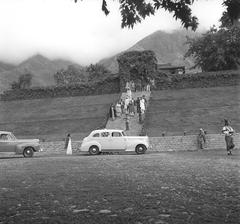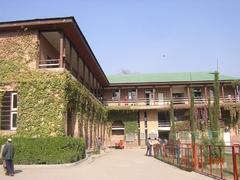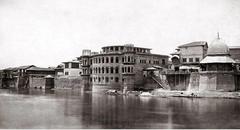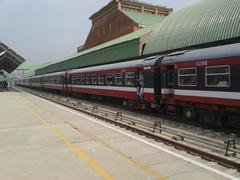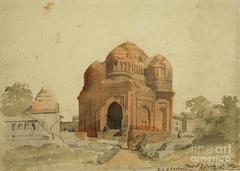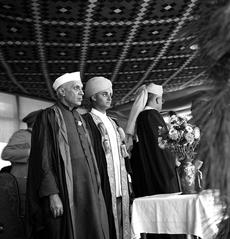Aali Mosque Srinagar: Visiting Hours, Tickets, and Comprehensive Guide to Historical Sites
Date: 14/06/2025
Introduction
Aali Mosque, also known as Aali Masjid, is an architectural and cultural jewel in the Eidgah area of Srinagar, Jammu and Kashmir. As the second-largest mosque in the Kashmir Valley, Aali Mosque is renowned for its distinctive wooden architecture, centuries-old history, and enduring role as a center of worship and community life. This guide provides an in-depth look at Aali Mosque’s origins, architectural features, restoration efforts, visiting hours, ticketing, travel tips, and connections to Srinagar’s broader heritage landscape. Whether you’re a traveler, student of architecture, or cultural enthusiast, this article is your essential resource for exploring one of Kashmir’s most significant historical landmarks.
Historical Overview and Cultural Significance
Origins and Construction
Aali Mosque was constructed in 1471 CE during the reign of Sultan Hassan Shah of the Shahmiri dynasty, marking a period of flourishing Islamic culture and learning in Kashmir. While some accounts suggest an earlier date under Sultan Ali Shah (1395 CE), the majority of historical and epigraphic evidence points to Sultan Hassan Shah as the principal patron (Khawar Khan Achakzai, 2023; Tourkicks.in). The mosque was intended as a grand congregational space, reflecting both religious devotion and the ambitions of the Sultanate period.
Architectural Significance
Aali Mosque is a rare example of hypostyle wooden mosque architecture in South Asia. Its prayer hall is supported by an impressive forest of 151–156 massive deodar (cedar) wood columns, each resting on intricately carved stone pedestals. The spacious prayer hall—measuring approximately 61.2 by 20.5 meters—creates a tranquil and open interior, while the modestly sloped roof is engineered to shed heavy Kashmiri snow (Archnet.org; Trek.zone). Traditional joinery techniques, without nails or metal fastenings, demonstrate the ingenuity of Kashmiri artisans.
Historical Adaptations
Throughout its existence, Aali Mosque has weathered the transitions of four major dynasties—Sultanate, Mughal, Afghan, and Dogra. Each era brought restoration, embellishments, or repairs, often in response to fires or neglect. Notable interventions include Mughal-era Safavid-style stone bases under portico balusters and significant reconstructions under Afghan and Dogra regimes. The mosque’s resilience mirrors the community’s ability to adapt and preserve its heritage through turbulent times (Kashmir Observer, 2024).
Spiritual and Community Role
Aali Mosque continues to serve as a hub for congregational prayers, especially during Eid and major festivals, accommodating thousands of worshippers. Its role extends beyond religion: during the Dogra era, it became a focal point for political gatherings and expressions of Kashmiri identity (Khawar Khan Achakzai, 2023). The mosque’s open grounds and welcoming atmosphere also foster interfaith understanding, reflecting Srinagar’s pluralistic traditions (Indian Holiday).
Architectural Features and Restoration
Spatial Layout and Construction
- Footprint: Rectangular, approx. 220 x 135 feet (67 x 41 meters), with a main prayer hall of 61.2 x 20.5 meters.
- Columns: 151–156 deodar wood columns, each 5 meters high and nearly 1 meter in diameter, rest on uniquely carved stone pedestals.
- Roof: Gently sloped and originally covered with birch bark, now replaced by wooden shingles or CGI sheets for durability.
- Ornamentation: Subtle yet refined, featuring floral and geometric woodcarvings, Pinjrakari latticework, and a six-stepped stone minbar.
Restoration and Conservation
Decades of neglect and fire damage necessitated major restorations throughout the mosque’s history. In the early 21st century, the Indian National Trust for Art and Cultural Heritage (INTACH), with support from the Aga Khan Trust for Culture and local authorities, spearheaded comprehensive restoration using traditional techniques and materials. These efforts have reinforced the mosque’s structure, revived its original aesthetic, and engaged the local community in heritage preservation (Archnet.org; Kashmir Observer, 2024).
Visitor Information
Location and Getting There
- Address: Eidgah area, Srinagar, Jammu and Kashmir
- Access: Easily reached by local taxis, auto-rickshaws, and public buses. Ask for directions to “Eidgah” or “Aali Masjid.”
Visiting Hours
- General Timings: Open daily from 7:00 AM to 7:00 PM, though some sources cite 4:00 AM to 9:30 PM. Check locally for variations during religious festivals and Fridays (Trek.zone).
- Peak Times: Fridays, Eid, and major prayer times attract large gatherings.
Entry and Tickets
- Entry Fee: Free for all visitors.
- Donations: Voluntary donations for upkeep are appreciated.
Dress Code and Etiquette
- Attire: Modest dress required. Men should wear long trousers and sleeves; women should cover their heads, arms, and legs.
- Shoes: Remove shoes before entering the prayer hall.
- Photography: Permitted in the courtyard and exterior; seek permission before photographing the interior or worshippers.
Accessibility
- Mobility: Some areas have uneven flooring and steps, posing challenges for visitors with mobility impairments.
- Facilities: Basic amenities like shoe racks and ablution areas are available. Restrooms may be present but are basic.
Best Time to Visit
- Season: Spring to early autumn (April–October) for pleasant weather. Early mornings and late afternoons offer quieter visits.
Enhancing Your Visit: Tips and Nearby Attractions
Travel Tips
- Visit during quieter hours for a serene experience.
- Respect local customs, especially during prayer times.
- Engage with mosque caretakers or local guides for deeper insights.
Nearby Attractions
- Jamia Masjid Srinagar: The largest mosque in Kashmir, notable for Indo-Saracenic architecture.
- Hazratbal Shrine: Revered Muslim shrine on Dal Lake.
- Khanqah-e-Moula: Oldest mosque in J&K, celebrated for its woodwork.
- Pathar Masjid: Notable Mughal-era stone mosque.
- Dal Lake & Mughal Gardens: Famous for shikara rides and historic landscaping.
- Shankaracharya Temple & Hari Parbat: Prominent Hindu and multi-faith heritage sites.
Local Experiences
- Explore Eidgah grounds and Old City markets.
- Sample Kashmiri cuisine nearby.
- Capture architectural details in soft natural light.
Frequently Asked Questions (FAQs)
Q: What are the visiting hours at Aali Mosque?
A: Typically 7:00 AM – 7:00 PM daily, but check locally for festival or Friday timings.
Q: Is there an entry fee?
A: No, entry is free. Voluntary donations are welcomed.
Q: Are non-Muslims allowed to visit?
A: Yes, non-Muslims are welcome but should avoid prayer times and dress modestly.
Q: Is photography allowed?
A: Permitted in exterior and courtyard; seek permission for interior or prayer hall photos.
Q: Are guided tours available?
A: Occasionally through local operators; advance booking recommended.
Visuals and Interactive Media
- Include images of the prayer hall, deodar wood columns, and carved ceilings (alt tags: “Aali Mosque Srinagar wooden architecture,” “Aali Mosque prayer hall pillars”).
- Interactive maps showing Aali Mosque and nearby attractions enhance trip planning (Archnet.org; Tourkicks.in).
Related Articles
Summary and Call to Action
Aali Mosque stands as an enduring testament to Kashmir’s rich history, distinctive wooden architecture, and resilient community spirit. Its hypostyle design and centuries of adaptation reflect the ingenuity of Kashmiri artisans and the layered narrative of the region. Restoration initiatives by organizations such as INTACH and support from the local community underscore a commitment to safeguarding this landmark for future generations (Khawar Khan Achakzai, 2023; Archnet.org; Kashmir Observer, 2024; Tourkicks.in).
Plan your visit to experience the mosque’s architectural marvels, tranquil atmosphere, and cultural legacy. Combine your trip with nearby historical sites to gain a holistic view of Srinagar’s heritage. For up-to-date information, downloadable guides, and curated tours, download the Audiala app and follow us on social media.
References
- Tourkicks.in: Aali Mosque Visiting Hours, Tickets, and History
- Khawar Khan Achakzai: Aali Mosque Srinagar – History & Significance
- Trek.zone: Aali Mosque in Srinagar – Visiting Hours & Highlights
- Kashmir Observer: Restoration of Religious Sites
- Archnet.org: Aali Mosque Architectural Documentation
- Indian Holiday: Religious Places in Srinagar
